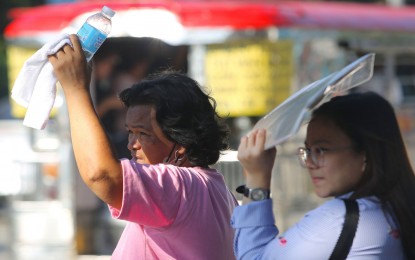
NOWHERE TO HIDE. Commuters wait for a ride under intense heat along Elliptical Road in Quezon City on Thursday afternoon (April 20, 2023). Experts advise awareness on the symptoms of heat stroke like heavy sweating, cold skin, fast or weak pulse, nausea or vomiting, muscle cramps, tiredness or weakness, and dizziness or headache. (PNA photo by Joan Bondoc)
MANILA – The El Niño alert may be officially released by May as the chances of its occurrence continue to rise.
The phenomenon, characterized by warmer than average temperatures, will be initially felt in Mindanao in October and will progress to the Visayas and Luzon, according to Marcelino Villafuerte, chief of the Climate Impact Assessment and Application of the Climatology and Agrometeorology Division under the Philippine Atmospheric, Geophysical and Astronomical Services Administration (PAGASA).
By July to September, the chances of El Niño will increase from the current 70 percent to 80 percent, with “above normal” rainfall before its actual start.
Early preparations and public cooperation are crucial to deal with the extreme weather system that may last until early 2024, Villafuerte said.
“We will have a weak to moderate El Niño so we have to prepare for it,” he said at the Saturday News Forum at a Quezon City restaurant.
Water conservation is among the major priorities.
“We have to conserve water. For example, when you are washing your hands or brushing your teeth, close the faucet. Don’t let water continuously flow,” said Sevillo David Jr., executive director of the National Water Resources Board.
“Simple efforts will have a huge impact in such a situation.”
The country last experienced El Niño from 2018 to 2019.
During its final month in July 2019, two tropical cyclones developed in the Philippine Area of Responsibility; moderate to heavy rains were felt in most parts of western Luzon, western Visayas, and some areas of western Mindanao; the water level of several dams in Luzon increased; and flooding, flashfloods, landslides, and soil erosion were reported in Cagayan, Cordillera, Central Luzon, Western Visayas, and Lanao del Norte that caused damage to agriculture.
Villafuerte advised staying indoors as much as possible and hydrating to prevent heat stroke.

The heat index was highest in Butuan City, Agusan del Norte on Friday at 48 degrees Celsius. It was between 41 degrees and 43 degrees in Metro Manila.
It is forecast to reach an “extreme danger” level of 56 degrees in Catbalogan City, Samar on Tuesday.
Heat index is defined as what the temperature feels like to the human body when relative humidity is combined with the air temperature. (PNA)
